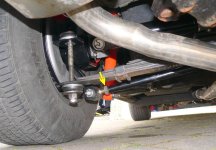antijam
CCCUK Member
In common with many C3 owners I found the stock rear camber cam adjustment at the inboard strut mount fiddly to set and liable to drift under road shock loads. Accordingly I replaced the fixed length struts with adjustables, these having opposite hand threaded rod ends allowing them to act as turnbuckles - rotate the strut in one direction to lengthen (induce negative camber) and in the other to shorten (induce positive camber). After setting the correct camber the strut length is locked by tightening lock nuts at each end. The stock struts are fitted with rubber bushes at each end which are prone to wear and in the adjustables I chose the bushes are polyurethane to give longer life.
After setting the camber roughly correct myself I had a professional alignment done on the rear end to set both camber and toe to factory spec. A few weeks later while glancing at the rear of the car I noticed that the negative camber on the left side was obviously greater then that on the right. A check revealed that both lock nuts on the strut were loose and it had obviously 'unwound' to increase the negative camber.

I have faith in the competence of the tech who did the set up and it's very unlikely that he neglected to tighten the locknuts after adjustment. I think the problem resides in the fact that as the trailing arm rises and falls it imposes a torque on the strut. In the original struts this torque was reacted by distortion in the rubber bushes; in the adjustables it is reacted in the stiffer poly bushes but it also tends to fret the rod ends, alternately applying tightening and loosening torques to the threads. I'm presuming this is what caused the locknuts to loosen.
A better solution than polybushes is to fit rod ends with Rose (Heim) joints instead. these will isolate the struts from applied torque. These are available and in hindsight are what I should have fitted instead - ah well! Until I can get them replaced I shall have to do regular checks on the struts integrity - in theory if loose, the struts could completely unwind causing collapse of the rear suspension - a situation best avoided!
After setting the camber roughly correct myself I had a professional alignment done on the rear end to set both camber and toe to factory spec. A few weeks later while glancing at the rear of the car I noticed that the negative camber on the left side was obviously greater then that on the right. A check revealed that both lock nuts on the strut were loose and it had obviously 'unwound' to increase the negative camber.

I have faith in the competence of the tech who did the set up and it's very unlikely that he neglected to tighten the locknuts after adjustment. I think the problem resides in the fact that as the trailing arm rises and falls it imposes a torque on the strut. In the original struts this torque was reacted by distortion in the rubber bushes; in the adjustables it is reacted in the stiffer poly bushes but it also tends to fret the rod ends, alternately applying tightening and loosening torques to the threads. I'm presuming this is what caused the locknuts to loosen.
A better solution than polybushes is to fit rod ends with Rose (Heim) joints instead. these will isolate the struts from applied torque. These are available and in hindsight are what I should have fitted instead - ah well! Until I can get them replaced I shall have to do regular checks on the struts integrity - in theory if loose, the struts could completely unwind causing collapse of the rear suspension - a situation best avoided!
